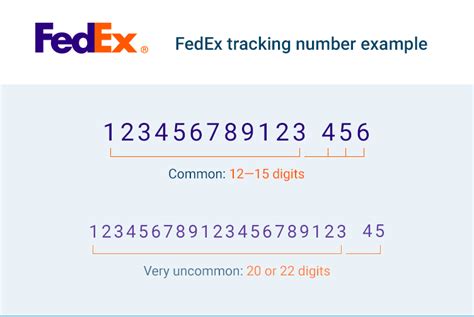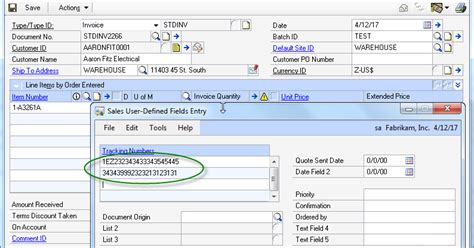Tracking Number Tracking Number

Tracking numbers have become an integral part of modern logistics and shipping operations, offering visibility and transparency throughout the supply chain. These unique identifiers enable both businesses and individuals to monitor the progress of their shipments, providing valuable insights and peace of mind. In an era where e-commerce and global trade are booming, understanding the intricacies of tracking numbers is crucial for efficient logistics management.
The Significance of Tracking Numbers in Logistics
Tracking numbers, also known as consignment numbers or reference codes, serve as digital footprints for packages and shipments. They are typically alphanumeric sequences assigned to each parcel, allowing for precise identification and tracking. The importance of these numbers extends beyond simple tracking; they play a pivotal role in enhancing customer service, optimizing delivery routes, and managing inventory effectively.
Benefits of Tracking Numbers for Businesses
For businesses engaged in e-commerce or supply chain management, tracking numbers offer a plethora of advantages. They enable real-time monitoring of shipments, allowing businesses to quickly identify and address any delays or issues. This proactive approach ensures customer satisfaction and timely delivery, both of which are paramount in today’s competitive market.
Furthermore, tracking numbers provide valuable data for analytics. By analyzing shipment patterns and delivery times, businesses can optimize their logistics strategies, reduce costs, and improve overall operational efficiency. This data-driven approach is essential for staying ahead in the dynamic world of logistics.
Enhancing Customer Experience with Tracking Numbers
From a customer perspective, tracking numbers offer transparency and convenience. Customers can follow the journey of their packages, receiving updates on delivery status and estimated arrival times. This level of visibility not only builds trust but also empowers customers to plan their schedules accordingly. Additionally, tracking numbers facilitate easy retrieval of shipment information, should any queries or concerns arise.
The Science Behind Tracking Number Systems
The implementation of tracking number systems involves intricate algorithms and data management. These systems are designed to accommodate vast volumes of shipments, ensuring accurate and timely updates. While the exact mechanisms may vary among shipping carriers, the core principles remain consistent, focusing on reliability and scalability.
How Tracking Numbers are Generated
Tracking numbers are typically generated using automated systems, often integrated with shipping software. These systems assign unique identifiers to each shipment, ensuring no two packages have the same tracking number. The generation process considers various factors, including the origin and destination of the shipment, as well as the specific carrier’s requirements.
Tracking Number Formats and Structures
The format and structure of tracking numbers can vary among shipping carriers and regions. Some common formats include a combination of letters and numbers, while others may use only numerical sequences. For instance, popular carriers like FedEx often use tracking numbers with a combination of letters and numbers, such as “9321011099”, while DHL might use a format like “1234567890”. Understanding these variations is essential for accurate tracking and data analysis.
| Carrier | Tracking Number Format |
|---|---|
| FedEx | Combination of Letters and Numbers (e.g., 9321011099) |
| DHL | Numerical Sequence (e.g., 1234567890) |
| UPS | Combination of Letters and Numbers (e.g., 1Z2345678901234567) |
| USPS | Numerical Sequence with Checksum (e.g., 9400110898822753723491) |
Data Security and Privacy in Tracking Number Systems
With the increasing reliance on tracking numbers, data security and privacy have become critical concerns. Shipping carriers employ robust encryption and authentication measures to safeguard sensitive shipment information. Additionally, privacy policies and regulations ensure that personal and logistical data remain protected throughout the tracking process.
Real-World Applications of Tracking Numbers
Tracking numbers find applications across various industries and sectors, revolutionizing the way businesses and individuals manage their shipments.
E-commerce and Online Retail
In the e-commerce landscape, tracking numbers are indispensable. They enable online retailers to provide customers with real-time shipment updates, enhancing the overall shopping experience. Moreover, tracking numbers facilitate efficient order fulfillment, inventory management, and customer support, all of which are vital for sustaining a successful online business.
Supply Chain Management
For supply chain professionals, tracking numbers are powerful tools for monitoring the movement of goods. They enable precise tracking of raw materials, finished products, and components, ensuring smooth supply chain operations. By analyzing tracking data, businesses can identify bottlenecks, optimize routes, and make data-driven decisions to improve overall efficiency.
Healthcare and Pharmaceuticals
In the healthcare sector, tracking numbers play a critical role in ensuring the timely delivery of medical supplies and pharmaceuticals. They enable healthcare providers and pharmacies to monitor the movement of life-saving medications and equipment, ensuring their availability when needed. This level of visibility is essential for maintaining patient safety and efficient healthcare operations.
The Future of Tracking Number Technology
As technology advances, the future of tracking number systems holds exciting possibilities. The integration of IoT (Internet of Things) devices, real-time location tracking, and AI-powered analytics is expected to revolutionize logistics further. These advancements will enhance the accuracy and speed of tracking, providing even greater visibility and control over shipments.
Emerging Technologies in Tracking Number Systems
The use of RFID (Radio-Frequency Identification) tags and GPS tracking devices is already transforming the way shipments are tracked. These technologies provide real-time location data, allowing for precise monitoring of packages. Additionally, blockchain technology is being explored for its potential to enhance data security and transparency in tracking number systems.
Implications for the Logistics Industry
The continued innovation in tracking number technology will have significant implications for the logistics industry. It will enable carriers and logistics providers to offer more efficient and reliable services, ultimately improving customer satisfaction. Moreover, the increased visibility and data insights will drive further optimization in supply chain management, reducing costs and enhancing overall operational performance.
Conclusion

Tracking numbers have evolved from simple identifiers to powerful tools that underpin the modern logistics landscape. They offer transparency, efficiency, and data-driven insights, benefiting businesses and customers alike. As technology continues to advance, the future of tracking number systems promises even greater capabilities, further revolutionizing the way we manage and track shipments.
How can I track my shipment using a tracking number?
+To track your shipment, visit the website of the shipping carrier and navigate to their tracking page. Enter your tracking number in the designated field and click “Track.” This will provide you with real-time updates on the status and location of your shipment.
What if my tracking number is not updating or showing any information?
+If your tracking number is not providing updates, it could be due to various reasons. First, ensure that you have entered the correct tracking number. If the issue persists, contact the shipping carrier’s customer support for further assistance. They can help investigate and provide accurate information on your shipment’s status.
Can I receive email or text notifications for my shipment’s progress using the tracking number?
+Yes, many shipping carriers offer the option to receive email or text notifications for your shipment’s progress. When tracking your shipment, look for the “Notification Settings” or “Alert Preferences” section on the carrier’s website. Here, you can sign up to receive updates via email or text message, ensuring you stay informed about your shipment’s journey.


